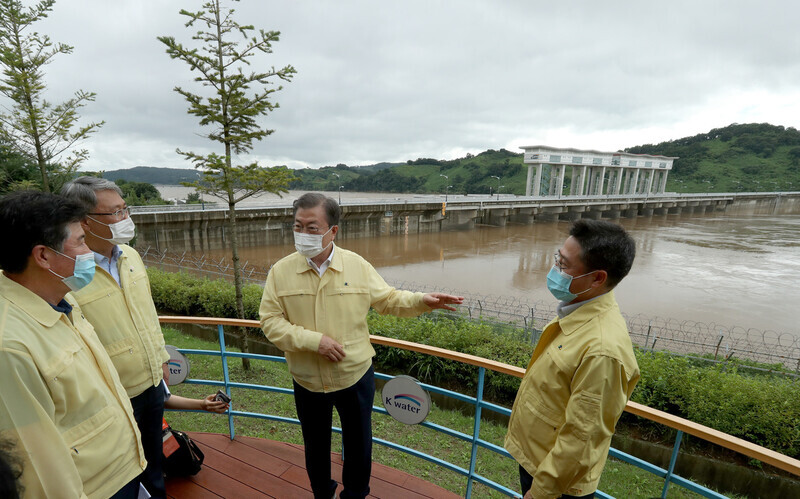hankyoreh
Links to other country sites 다른 나라 사이트 링크
Moon expresses regrets over N. Korea’s failure to give notice before opening floodgates of Hwanggang Dam

On Aug. 6, South Korean President Moon Jae-in commented on North Korea’s failure to give prior notification before opening the floodgates on the Hwanggang Dam, on the upper section of the Imjin River.
“If North Korea had let us know it was planning to release water from the Hwanggang Dam, it would have helped us manage the volume of water at the Gunnam Dam, but unfortunately that didn’t happen. South and North Korea had agreed to do that in the past, but that agreement isn’t being implemented,” Moon said while paying a visit to Gunnam Dam, in Yeoncheon County, Gyeonggi Province, on Thursday afternoon to inspect the government’s response to flood damage.
South Korea built Gunnam Dam on the middle section of the Imjin River in 2010 to prevent any possible damage from the North releasing water from Hwanggang Dam without prior warning.
Hwanggang Dam is located on the Imjin River in North Korea. Located approximately 26 miles north of the DMZ, the dam has an estimated capacity of 400 million tons.
While checking with officials from the Korea Water Resources Corporation during his visit, Moon asked them to keep track of weather forecasts and South Korean intelligence about water being released from Hwanggang Dam and to use the floodgates at Gunnam Dam to keep the river at an appropriate level.
During his opening remarks at the 316th meeting of the Inter-Korea Exchange and Cooperation Promotion Council, held at the Central Government Complex in Seoul on Thursday morning, Unification Minister Lee In-young expressed his “regret over North Korea’s recent decision to unilaterally release water.”
Since confirming that North Korea had opened the floodgates at Hwangang Dam on several occasions, the Ministry of Unification (MOU) has repeatedly asked North Korea to provide preliminary notification of plans to release water in keeping with an inter-Korean agreement concluded in October 2009.
Humanitarian concerns are of utmost importance, regardless of inter-Korean politics“No matter how difficult the political and military situation facing South and North Korea may be, the two sides need to immediately resume communication about humanitarian aid and in areas that are directly connected to the safety of Koreans in the border region. Any channel for communicating [prior notification] would be acceptable, including loudspeakers,” Lee said.
“Our hope is that the distrust between South and North Korea and uncertainty over water levels on the Imjin River can be converted into a surge of inter-Korean cooperation. We hope that North Korea will engage with a bold and generous decision.”
“We hope that [North Korea] will immediately inform South Korea and Gyeonggi Province through one channel or another when it releases water from Hwanggang Dam,” Gyeonggi Province Gov. Lee Jae-myung urged in a statement on the previous day, Aug. 5.
“Since Hwanggang Dam is on the upper stretches of the Imjin River, North Korea releasing water there can create a sudden and dangerous rise in the water level on the lower stretches of the river, in Yeoncheon County and Paju. Protecting innocent people from natural disasters is not only basic human decency but also the minimum concern we should show our fellow Koreans,” the governor said.
The water level at Pilseung Bridge, the northernmost point of the Imjin River south of the Military Demarcation Line, reached its highest point ever, 13.12m, on the evening of Aug. 5, triggering a flood warning for the Imjin River basin. Gyeonggi Province said on Aug. 6 that it had responded by evacuating 1,466 citizens in at-risk lowlands near the river in Yeoncheon and Paju to designated shelters.
By Lee Je-hun, senior staff writer, Kim Gi-seong, South Gyeonggi correspondent, and Park Kyungman, North Gyeonggi correspondent
Please direct comments or questions to [english@hani.co.kr]

Editorial・opinion
![[Editorial] Penalties for airing allegations against Korea’s first lady endanger free press [Editorial] Penalties for airing allegations against Korea’s first lady endanger free press](https://flexible.img.hani.co.kr/flexible/normal/500/300/imgdb/original/2024/0502/1817146398095106.jpg) [Editorial] Penalties for airing allegations against Korea’s first lady endanger free press
[Editorial] Penalties for airing allegations against Korea’s first lady endanger free press![[Editorial] Yoon must halt procurement of SM-3 interceptor missiles [Editorial] Yoon must halt procurement of SM-3 interceptor missiles](https://flexible.img.hani.co.kr/flexible/normal/500/300/imgdb/child/2024/0501/17145495551605_1717145495195344.jpg) [Editorial] Yoon must halt procurement of SM-3 interceptor missiles
[Editorial] Yoon must halt procurement of SM-3 interceptor missiles- [Guest essay] Maybe Korea’s rapid population decline is an opportunity, not a crisis
- [Column] Can Yoon steer diplomacy with Russia, China back on track?
- [Column] Season 2 of special prosecutor probe may be coming to Korea soon
- [Column] Park Geun-hye déjà vu in Yoon Suk-yeol
- [Editorial] New weight of N. Korea’s nuclear threats makes dialogue all the more urgent
- [Guest essay] The real reason Korea’s new right wants to dub Rhee a founding father
- [Column] ‘Choson’: Is it time we start referring to N. Korea in its own terms?
- [Editorial] Japan’s rewriting of history with Korea has gone too far
Most viewed articles
- 1[Editorial] Penalties for airing allegations against Korea’s first lady endanger free press
- 2Months and months of overdue wages are pushing migrant workers in Korea into debt
- 360% of young Koreans see no need to have kids after marriage
- 4In rejecting statute of limitations defense in massacre case, Korean court faces up to Vietnam War a
- 5Historic court ruling recognizes Korean state culpability for massacre in Vietnam
- 6“Those souls can rest now”: Vietnam massacre survivor reacts to Korean court win
- 7Bills for Itaewon crush inquiry, special counsel probe into Marine’s death pass National Assembly
- 8[Reporter’s notebook] In Min’s world, she’s the artist — and NewJeans is her art
- 9[Editorial] Verdict on Korea’s massacre in Vietnam a first step in atonement
- 101 in 3 S. Korean security experts support nuclear armament, CSIS finds